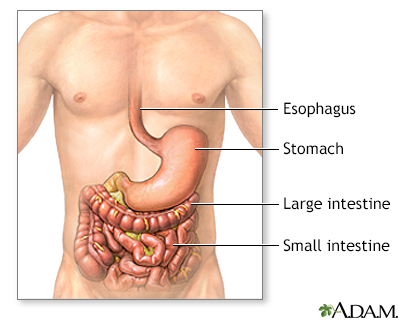Health exams for: #AGEGROUP#
The following exams, tests, and procedures are recommended for #AGEGROUPLOWER#.#FEMALETEXT#
Select a link from the list below to learn how and why each test is performed, as well how to prepare for it.

The following exams, tests, and procedures are recommended for #AGEGROUPLOWER#.#FEMALETEXT#
Select a link from the list below to learn how and why each test is performed, as well how to prepare for it.





The gastrointestinal tract starts at the mouth, which leads to the esophagus, stomach, small intestine, colon, and finally, the rectum and anus. The GI tract is basically a long, hollow, muscular tube through which food passes and nutrients are absorbed.
The gastrointestinal tract starts at the mouth, which leads to the esophagus, stomach, small intestine, colon, and finally, the rectum and anus. The ...
Inflammatory bowel disease is a condition in which the innner lining of the GI tract becomes inflamed, leading to ulcers and bleeding. The colon is most often the site of this inflammation. Patients with inflammatory bowel disease have symptoms that include diarrhea, abdominal pain, infections, and bleeding. Inflammatory bowel disease falls under two main headings Crohn's disease, which involves the entire GI tract, and ulcerative colitis, which involves only the colon. The cause of inflammatory bowel disease is unknown.
Inflammatory bowel disease is a condition in which the innner lining of the GI tract becomes inflamed, leading to ulcers and bleeding. The colon is m...
The primary treatment for inflammatory bowel disease involves medications, such as steroids, which can decrease inflammation and resolve symptoms. Occasionally, if segments of bowel are very inflamed and are not responding to medication, surgery to remove these segments may be necessary. While the patient is deep asleep and pain-free (general anesthesia), an incision is made in the midline of the abdomen.
The primary treatment for inflammatory bowel disease involves medications, such as steroids, which can decrease inflammation and resolve symptoms. Oc...
The inflamed segment of the colon or small intestine is removed and the healthy ends are sewn back together.
The inflamed segment of the colon or small intestine is removed and the healthy ends are sewn back together.
The removal of one section does not preclude recurrence of symptoms in other areas of the intestine. The course of inflammatory bowel disease is often variable. Some patients experience only mild symptoms, while others have more debilitating symptoms.
The removal of one section does not preclude recurrence of symptoms in other areas of the intestine. The course of inflammatory bowel disease is ofte...
Review Date: 1/30/2023
Reviewed By: Michael M. Phillips, MD, Emeritus Professor of Medicine, The George Washington University School of Medicine, Washington, DC. Also reviewed by David C. Dugdale, MD, Medical Director, Brenda Conaway, Editorial Director, and the A.D.A.M. Editorial team.



